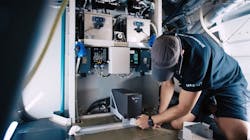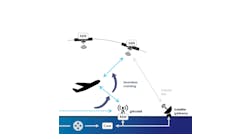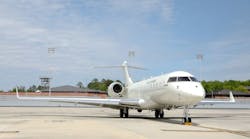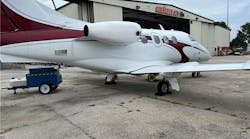On-board connectivity on business jets is increasingly necessary for business aircraft operators in order to be competitive; indeed, there are multiple options available for onboard Wi-Fi installations. In this article, we review repair processes and what to expect for the future of connectivity.
Repair Processes
Inflight Wi-Fi can be installed as a component on a new aircraft or at an MRO facility in an aftermarket upgrade, explains Harry Shadbolt, global partner director for Viasat’s recently acquired Inmarsat business. “On a new aircraft, the airframe original equipment manufacturer (OEM) is responsible for both installation and verification prior to delivery to the end customer. Each OEM will have written test procedures that they will follow as part of the formal aircraft delivery process,” he says. “MRO testing is a similar process to OEM line-fitting, but it is typically performed alongside the aircraft owner’s selected value-added reseller (VAR), a team that will also manage the customer’s Wi-Fi subscription service.”
In both cases, the Wi-Fi system will be tested when the terminal first connects to the satellite. For testing, a range of onboard devices will access multiple internet sites at once and the user experience will be observed, according to Shadbolt. “Both the VARs and OEMs can also access specific technical diagnostic tools to quantify specific aspects of the satellite connection and its performance. When it comes to troubleshooting a system that’s operating inefficiently, or not at all, the operator will firstly contact their VAR service provider, who will take them through a series of troubleshooting steps, and if required, facilitate the repair or replacement of the terminal,” he says.
According to Adam Sheppard, director of aircraft connectivity at Honeywell Aerospace, the repair process can be fairly complex as the need could be for an avionics fault, a wiring fault, a satellite fault, or a (ground) network fault. “The best repair support typically comes from the team that is the most knowledgeable on all three. With Honeywell providing over 90% of all SATCOM systems to business aviation, being a major service provider and being intimately familiar with the satellite providers we typically feed most of the support calls for all service providers and lead to the fast support resolution,” he says.
In case a repair process is needed, some trouble shooting procedures come from SatCom Systems, explains Siegfried Axtmann, chair of FAI Aviation Group. “The diagnostic unit detects the defect component to be repaired/replaced by 90% if the fault is not caused by a wiring problem,” he says.
Evolution of Connectivity
According to Michael Skou Christensen, chief commercial officer of Satcom Direct, the technology around Wi-Fi and cabin connectivity is advancing at a rapid rate, and today operators require multiple connectivity solutions to achieve the performance and resilience requirements. “This means there are many considerations when evaluating which solution to select and install and, for customers and MROs, the selection process is no longer just a case of choosing a single frequency, Ka or Ku-band, but more than ever, it requires analysis of usage, destinations, passenger numbers and airframe type,” he says. “Equipping the right aircraft antenna is essential for data transmission to and from the aircraft. The good news is that all constellations can provide near-global coverage if they can see a ground station, and the right mix of satellite networks can deliver unbroken coverage.”
Satcom Direct is already seeing signs that the multi-orbit offering will become the norm for aircraft that frequently fly around the globe. “With the SD Plane Simple antenna series, upgradeable terminals, customers can harness the different frequencies and orbits via multiple network operators to assure the reliability and longevity of the airborne connection. SD solutions are designed to operate with existing and future network constellations, and we have designed our hardware to easily upgrade to the system that leverages the most suitable network,” says Skou Christensen.
What has been reached is an important turning point in business aviation, where simply having connectivity onboard is no longer enough, affirms Shadbolt. “With a demanding customer base that includes high-net-worth individuals and corporations, passenger expectations have significantly evolved in recent years, especially since the pandemic, as the importance of staying connected, whether for business or leisure purposes, has heightened,” he says. “The focus has shifted from simply having it onboard to meeting expectations around quality of service. These passengers need the certainty that reliable, consistent, high-speed connectivity will be available, wherever and whenever they are flying. That is exactly what we strive to deliver with our solutions. We are enabling passengers to make the most of their time onboard, whether that is for business, entertainment, or simply staying in touch with family, friends, and colleagues.”
Wi-Fi installations and new SATCOM solutions in business jets are constantly evolving, however the wiring for a SATCOM most likely will not differ significantly, an area that is still ripe for innovation will be the network side of the aircraft, affirms Sheppard. “If one takes one’s house as an example, in most instances regardless of the service provider one will balance the speeds, productivity, support and software that one needs with the cost one is willing to pay. However, getting that same high throughput in every room in the house tends to only happen through a wireless connection between the router and network extenders in the house (a mesh network). In the case of an aircraft, everything is wired and as innovation evolves and throughput increases, the on-wing network will need to innovate and act more and more as mesh networks on aircraft,” he says. “Most people simply look at the SATCOM as the primary upgrade but forget the full end to end solution (Aircraft Network, SATCOM, Satellite Network, and Ground Network) plays a major part the passenger experience. Honeywell is not only focused on innovating the SATCOM with the development of Next Generation JetWave as well as Swift Jet but also innovating in every aspect of the customer solution including the aircraft and ground networks.”
Future of Connectivity
According to Axtmann, ultra-high speed connectivity is becoming more and more a must for medium and long distance charter flights. “All operators sooner or later will have to offer such services because people just need and want to stay connected,” he says.
Owners of large cabin long-range or executive airliners already demand double or sometimes triple redundancy, which increases the amount of data that must be transmitted to and from the aircraft and, consequently, the bandwidth available, observes Skou Christensen. “Digital communications, aircraft performance monitoring, and crew operations can be enhanced by installing two or sometimes three alternative systems. In addition, data can also be prioritized for chosen passenger devices, ensuring principals and key stakeholders always maintain the required connectivity they need,” he says. “The one certain element of the future of cabin Wi-Fi is that passengers will continue to want more data, more quickly, for more devices, and to emulate the on-the-ground connectivity experience in the air seamlessly.”





